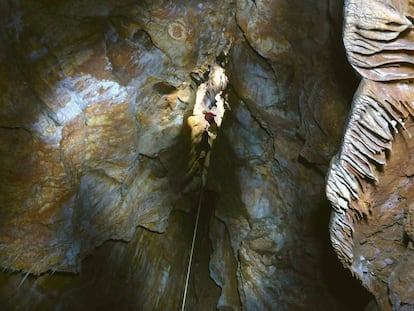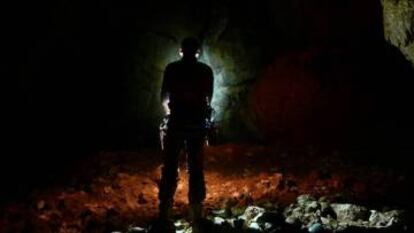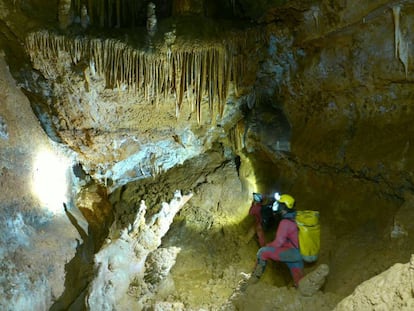Spain’s CJ-3: a cave as beautiful as it is deadly
Scientists are investigating why this well-known chasm has suddenly run out of oxygen
“What I want to do is to breathe,” says geologist Raúl Pérez. His eyes are like a rabbit’s caught in headlights. His mouth is agape, like a fish out of water. Pérez has just poked his head out of the narrow opening of CJ-3, a 50-meter-deep cave hidden away in a pine forest in the Cañon del Río Lobos, near Casarejos in the central province of Soria. His two colleagues still inside, Antonio Marcos and Jesús Carballo are blowing their emergency whistles.

A geologist at Spain’s Geological and Mining Institute (IGME), Pérez says the first call they got from the Cañón de Río Lobos Natural Park asking for help was in 2014. CJ-3, well known to Spanish spelunkers for its incredible formations, no longer had enough oxygen and nobody could work out why. A young woman had fallen unconscious while exploring there and had to be rescued. Other visitors had experienced breathing problems. It was as though an invisible killer was hiding inside.
It’s not normal to find a cave without oxygen Raúl Pérez, geologist
Pérez and his colleagues are specialists in dangerous caves, and embarked on their first expedition to CJ-3 in December, 2014, going down without breathing equipment. At the bottom of the chasm, Marcos started to note the effect of the lack of oxygen – a loss of muscular coordination, rapid breathing and tachycardia – signs that only highly-trained people are able to recognize before falling unconscious. Marcos immediately sounded the alarm and ordered an exit from the cave.
“It can be lethal and it can cause very serious problems. Space and time disappear inside,” says Marcos, a member of a mountain rescue team. “It’s like being 6,000 meters up a mountain,” agrees Carballo.

On December 19, 2016, the three men entered the cave again, this time with breathing kit, to measure the quality of the air and take soil samples. At the mouth of the cave where a sign warns cavers to keep out, the trio start their descent using a 65-meter-long rope that brings them into an open horizontal space 30 meters high, populated by bats. In the bowels of the cave, the group measure oxygen concentration at 17.5% compared to 21% in the forest above. “That’s the difference between normal air and unbreathable air,” says Pérez.
All three men are used to entering caves where oxygen is scarce. In September 2015, they went into the Sima del Vapor in Alhama, Murcia, where the temperature rises above 40ºC and carbon dioxide is highly concentrated.
The exploration of the Murcia cave formed part of a project called Sismosima, set up to study temperatures associated with earthquakes in caves in seismic zones and the possibility of gas spikes. The Sima del Vapor is on the fault line that shook the city of Lorca in 2011, killing nine people.

“It’s not normal to find a cave without oxygen,” says Pérez, referring to CJ-3. More unusual still is a sudden lack of it. According to Pérez there are three possible explanations; bacteria producing carbon dioxide deep within the cave; a sudden release of gases during an earthquake or, thirdly, the release of gases in a cave close to volcanic activity. “This is neither an earthquake nor a volcanic zone so we are looking at the first possibility,” he says.
The analysis of the soil and the four samples of air should solve the mystery of a cave that was once a place of initiation for caving federations across Spain.
“A fence will be needed to close off the opening to the cave,” says Pérez, who understands the adventurous and sometimes irresponsible nature of cavers. As mythologist and author of The Hero with a Thousand Faces, Joseph Campbell wrote: “The cave you fear to enter holds the treasure you seek.”
English version by Heather Galloway.
Tu suscripción se está usando en otro dispositivo
¿Quieres añadir otro usuario a tu suscripción?
Si continúas leyendo en este dispositivo, no se podrá leer en el otro.
FlechaTu suscripción se está usando en otro dispositivo y solo puedes acceder a EL PAÍS desde un dispositivo a la vez.
Si quieres compartir tu cuenta, cambia tu suscripción a la modalidad Premium, así podrás añadir otro usuario. Cada uno accederá con su propia cuenta de email, lo que os permitirá personalizar vuestra experiencia en EL PAÍS.
¿Tienes una suscripción de empresa? Accede aquí para contratar más cuentas.
En el caso de no saber quién está usando tu cuenta, te recomendamos cambiar tu contraseña aquí.
Si decides continuar compartiendo tu cuenta, este mensaje se mostrará en tu dispositivo y en el de la otra persona que está usando tu cuenta de forma indefinida, afectando a tu experiencia de lectura. Puedes consultar aquí los términos y condiciones de la suscripción digital.
More information
Últimas noticias
From Andorra to Gibraltar, a black market for Ozempic exploits its success: ‘They’re the most sought-after products in the world’
The brief rise and retreat of Generation Z in Mexico
From safe-haven investment to geostrategic weapon: Who owns the most gold and where are the bars kept?
Todd Green, head of the company that created ‘Candy Crush’: ‘Success for us is that players want to play for years’
Most viewed
- Why we lost the habit of sleeping in two segments and how that changed our sense of time
- Charles Dubouloz, mountaineering star, retires at 36 with a farewell tour inspired by Walter Bonatti
- Venezuela faces its most tense Christmas yet
- CBS in crisis after pulling a report on Trump’s deportations to El Salvador (which later leaked online)
- Bukele clan fumes over investigation exposing their new wealth










































